The Berkshires Bowling Alley that Inspired "The Big Lebowski"
It’s been 36 years since the release of The Big Lebowski, the irreverent cult comedy by Joel and Ethan


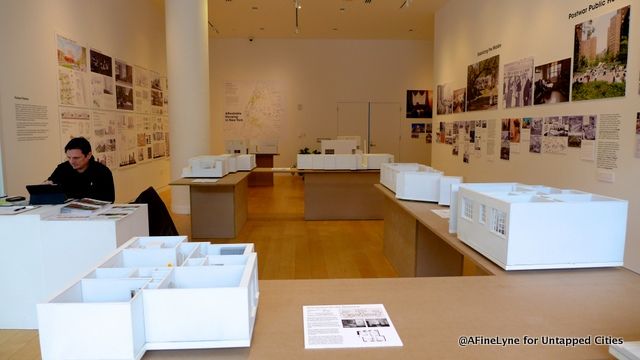
With affordable housing high on the agenda of the de Blasio administration, and on the minds of New Yorkers, Hunter East Harlem Gallery is exploring this highly charged topic from its inception to present day, with the new exhibit “Affordable Housing in New York.” The exhibit is located in East Harlem’s El Barrio, a neighborhood sure to be impacted by the administrations decisions, since it is among the first seven neighborhoods that Mayor de Blasio hopes to rezone. The timeline in the exhibit, which is broken down into six sections beginning in 1926, documents not just the architecture and politics, but also the people who live there and have called these houses home for decades.
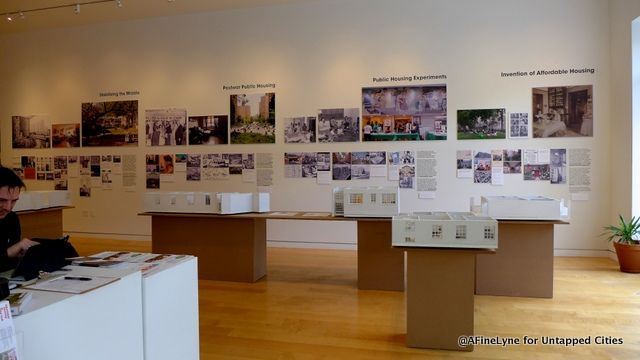 Timeline of affordable housing from 1926 to present
Timeline of affordable housing from 1926 to present
The exhibit hopes to not only explore the past 100 years of affordable housing, but also to inspire creative solutions for the future. Here below are a highlight of the sections of the exhibit:
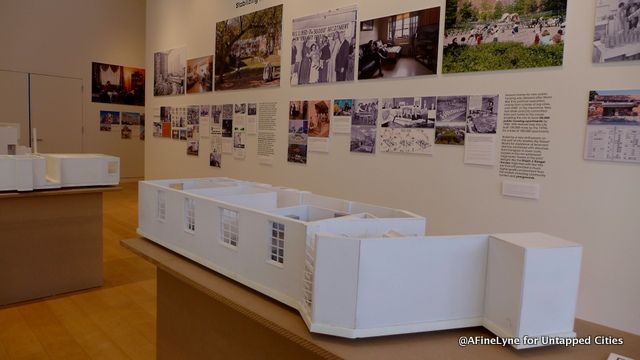 Timeline wall to the right; a model of Queensbridge Houses in the forefront
Timeline wall to the right; a model of Queensbridge Houses in the forefront
The public housing program, Queensbridge Houses, in Long Island City, was completed in 1940 and consisted of 3,149 units in a complex consisting of 29 six-story buildings. This was NYCHA-sponsored housing built by W.F.R. Ballard, Henry S. Churchill, Frederick G. Frost, and Burnett Turner. They were built as low-cost apartments, with cement floors and ceilings which were then painted, and closets using curtains instead of doors. The rent for a 4 1/2 room apartment was $22.75 per month. Today, rent is based on a percentage of the tenant’s income. The complex, the largest in the country, houses about 7,000 people.
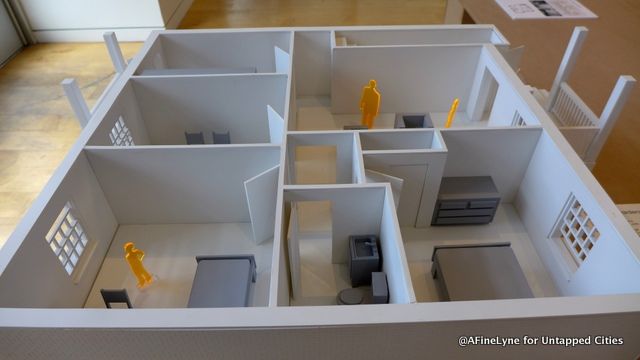
Sunnyside Gardens was built in 1928 by a private nonprofit, City Housing Corporation, Limited-Equity Co-ops, and contains 1,202 units. They were designed by architects Clarence Stein, Henry Wright, and Frederick Ackerman, in partnership withlandscape architect Marjorie Sewell Cautley, with the goal of integrating urban family life with the natural surroundings of green space at front and back. The units had large windows facing common gardens, with front and rear porches. Many of the units included dining rooms, often turned into a third bedroom by the tenants. Sunnyside Gardens is listed as a historic district on the National Register of Historic Places, and is among the first planned communities in the United States.Model of Queensbridge Houses, which was completed in 1940
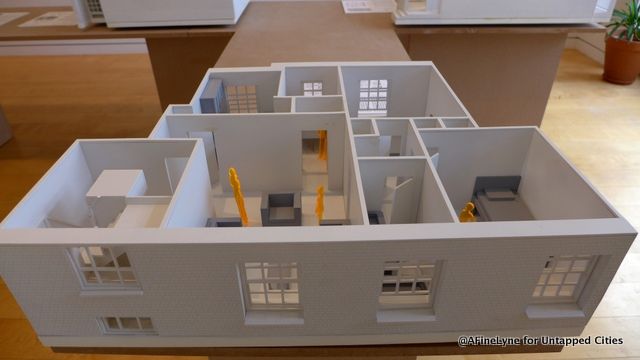 The historic Dunbar Apartments was home to many writers and jazz musicians
The historic Dunbar Apartments was home to many writers and jazz musicians
The historic Paul Laurence Dunbar Apartments, located at 246 West 150th Street, is a complex of buildings that runs a square block from Frederick Douglass Boulevard to Adam Clayton Powell Jr. Boulevard. The five-acre complex, made up of six separate buildings, was built in 1926 by architect Andrew J. Thomas, through the private philanthropist John D. Rockefeller, Jr.
These 511 units were built to specifically provide housing for African-Americans, and were high-quality, below-market housing, contracted by the private sector without government aid. The units included decorative treatments like crown molding, and large windows that faced both the street and the inner courtyard. The complex was a housing cooperative, whereby tenants were required to pay a down-payment of $50 per room, and then $14.50 per room per month, which went toward a mortgage lasting twenty-two years, upon which time the tenant would own the unit.
This was the first large cooperative offered to African-Americans, and named in honor of the noted African-American poet. It was home to such famous residence as W.E.B. DuBois, Paul Robeson, A. Philip Randolph, the poet Countee Cullen, Bill “Bojangles” Robinson, and the explorer Matthew Henson. However because so many tenants defaulted on their payments, the building foreclosed in 1936, becoming rental units a year later. The Dunbar Apartments was designated a New York City Landmark in 1970, and listed on the National Register of Historic Places in 1979.
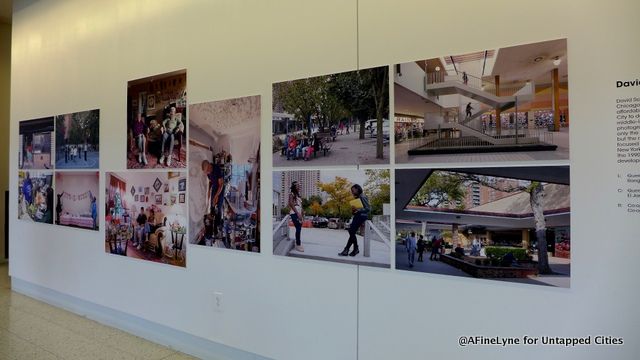 Images along the walkway to the gallery entrance by photographer David Schalliol
Images along the walkway to the gallery entrance by photographer David Schalliol
The varied architecture of New Yorks affordable housing was documented in 2014 by David Schalliol, a photographer and sociologist based in Chicago and Minneapolis. On view along the corridor leading to Hunter East Harlem Gallery are his photographs of Queensbridge Houses, Rangel Houses, Co-op City, Harlem River Houses, El Jardin de Selene in the Bronx, the Dunbar Apartments and Rochdale Village in Queens.
Today, affordable housing in New York is provided and subsidized by many different city agencies, non-profits, and developers, to not only provide housing, but also to help keep tenants in their housing year after year. One such program geared toward Seniors is the lesser-known SCRIE Program, which allows seniors living in affordable housing to freeze their rent. Organizations such as NYC HDFC provide assistance in navigating through the paperwork, and even have a SCRIE Delivery Unit that will go to buildings and speak to groups of seniors, bringing with them a Notary Public, an attorney and all the necessary paperwork to walk seniors through the process easily.
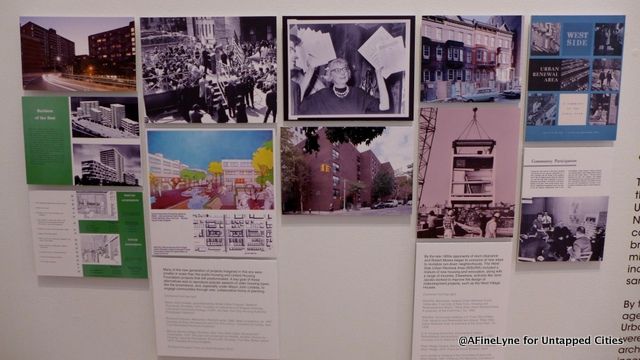 Many well-known figures in grassroots preservation efforts are included in the exhibit
Many well-known figures in grassroots preservation efforts are included in the exhibit
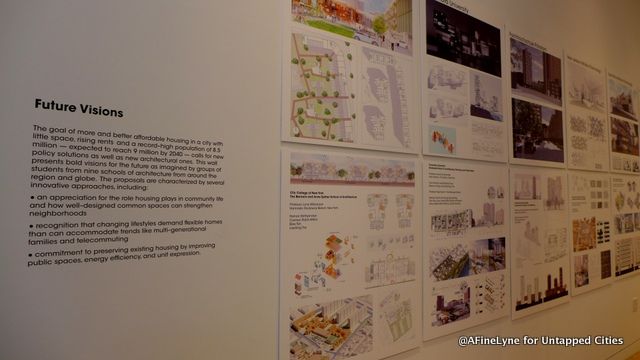
With a rising population in New York City expected to reach nine million by 2040, what might be the future of affordable housing? Students from nine schools of architecture put forth their bold visions, considering new social trends like telecommuting or housing multi-generational families, and creative ways of preserving existing housing and improving public spaces.
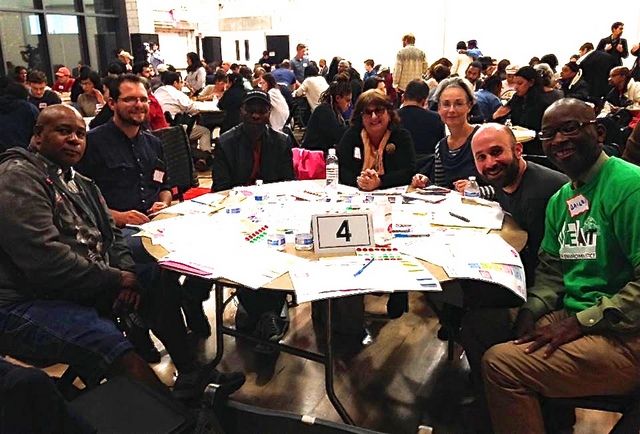 Table 4 in the East Harlem Neighborhood Planning and Rezoning workshop with participants from We Act, Marcus Garvey Park Alliance, urban planning students and community residents.
Table 4 in the East Harlem Neighborhood Planning and Rezoning workshop with participants from We Act, Marcus Garvey Park Alliance, urban planning students and community residents.
In the El Barrio neighborhood, an East Harlem Neighborhood Planning and Rezoning group was formed last year, spearheaded by City Council Speaker Melissa Mark-Viverito. Its goal was to develop a vision and strategy for the implementation of more affordable housing and to address related issues, based on the community’s needs. Community visioning workshops took place over a six-month period during 2015, with over 500 surveys and seven public meetings.
Mark-Viverito formed an impressive nineteen member Steering Committee that compiled and evaluated the results from the community workshop project, and the final plan was given to the Department of City Planning (DCP) with the hope that it will influence how the city moves forward. This communication and community engagement between business leaders and government is a giant step forward from the original affordable housing days.
The sub-groups at these workshops worked on actual models, and addressed issues related to affordable housing like open space, height restrictions, zoning, land use and preserving green space. It was a comprehensive lesson in learning the difficulties of compromise involved in these projects, especially when participants were faced with using the current AMI (area median income which determines income caps on affordable housing), a standard of measurement that appears to be far from realistic in actuality. In addition, they explored the problems associated with the loss of current affordable housing and mom-and-pop shops, which are a large part of the preservation of the neighborhood’s distinct culture.
“Affordable Housing in New York” will be on view at Hunter East Harlem, 2180 Third Avenue at 119th Street, through May 15. It is curated by Matthew Gordon Lasner, Hunter College, Matthias Altwicker, New York Institute of Technology, and Nicholas Dagen Bloom, New York Institute of Technology. In addition to the gallery exhibit, there will be a series of related talks based on the companion book Affordable Housing in New York and a series of walking tours, visiting many of the historic affordable houses featured in the gallery.
Just nearby at the Museum of the City of New York is another excellent exhibit on affordable housing, Affordable Housing: A New York Legacy. Get in touch with the author at AFineLyne.
Subscribe to our newsletter